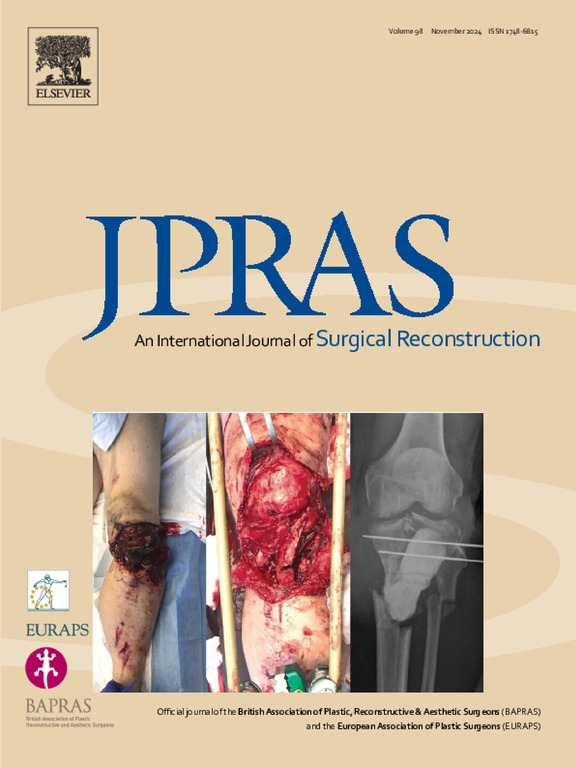一种新型显微外科教学模拟器:显微外科竞技场
IF 2
3区 医学
Q2 SURGERY
Journal of Plastic Reconstructive and Aesthetic Surgery
Pub Date : 2025-02-27
DOI:10.1016/j.bjps.2025.02.051
引用次数: 0
摘要
显微外科的模拟对于技能的习得和维持是必不可少的。本研究评估了Microsurgery Arena的结构和面部有效性。Microsurgery Arena是一种低保真模拟器,旨在改善显微镜下的手部和手腕运动,提高仪器操作和打结技能,并始终如一地评估用户的表现。21名外科学员参加了为期3天的显微外科技术入门课程。参与者在课程前后分别进行了“障碍回转”和“系绳结”两项预先设定好的协调练习。完成练习所需的时间被记录下来。练习视频是匿名的,随机的,并由3个独立的评分者-一个高级实验显微外科医生,一个高级临床显微外科医生和一个初级住院医生-使用斯坦福显微外科住院医生培训量表进行评估。在课程结束时,参与者还完成了人口统计和面部效度问卷。对课前分数和课后分数的定量分析显示,在所有被测试的技能上都有统计学上的显著提高。此外,面部效度评估显示了参与者高度积极的反馈。绝大多数候选人发现该设备作为显微外科的初始训练模型非常或非常有用。此外,该模型具有区分训练前后技能水平的能力,支持了其结构效度。作为一种低成本和可获得的模型,它提供了一种标准化的方法来发展基本的显微外科技能。该模拟器有潜力为学生、住院医师和显微外科新手提供有效的评估和培训工具,有助于提高显微外科培训计划中的技能获得。本文章由计算机程序翻译,如有差异,请以英文原文为准。
Face and construct validity of a novel simulator for microsurgical education: Microsurgery Arena
Simulation in microsurgery is essential for skill acquisition and maintenance. This study evaluated the construct and face validity of the Microsurgery Arena, a low-fidelity simulator designed to improve hand and wrist movements under the microscope, enhance instrument handling and knot-tying skills, and consistently assess user performance.
Twenty-one surgical trainees participated in 3-day introductory microsurgical skills courses. Participants performed 2 predefined coordination exercises, “slalom” and “tie-the-knot,” before and after the course. The time required to complete the exercises was recorded. The videos of the exercises were anonymized, randomized, and evaluated by 3 independent raters—a senior experimental microsurgeon, a senior clinical microsurgeon, and a junior resident—using the Stanford Microsurgery Residents Training Scale. Participants also completed demographic and face validity questionnaires at the end of the course.
Quantitative analysis of pre-course scores vs post-course scores showed a statistically significant improvement in all examined skills. Moreover, the face validity assessment revealed highly positive feedback from the participants. The vast majority of candidates found the device extremely or very useful as an initial training model in microsurgery. Moreover, the model demonstrated its ability to discriminate between skill levels before and after training, supporting its construct validity. As a low-cost and accessible model, it provides a standardized approach for developing essential microsurgical skills. This simulator has the potential to serve as an effective assessment and training tool for students, residents, and microsurgical novices, contributing to improved skill acquisition in microsurgical training programs.
求助全文
通过发布文献求助,成功后即可免费获取论文全文。
去求助
来源期刊
CiteScore
3.10
自引率
11.10%
发文量
578
审稿时长
3.5 months
期刊介绍:
JPRAS An International Journal of Surgical Reconstruction is one of the world''s leading international journals, covering all the reconstructive and aesthetic aspects of plastic surgery.
The journal presents the latest surgical procedures with audit and outcome studies of new and established techniques in plastic surgery including: cleft lip and palate and other heads and neck surgery, hand surgery, lower limb trauma, burns, skin cancer, breast surgery and aesthetic surgery.

 求助内容:
求助内容: 应助结果提醒方式:
应助结果提醒方式:


